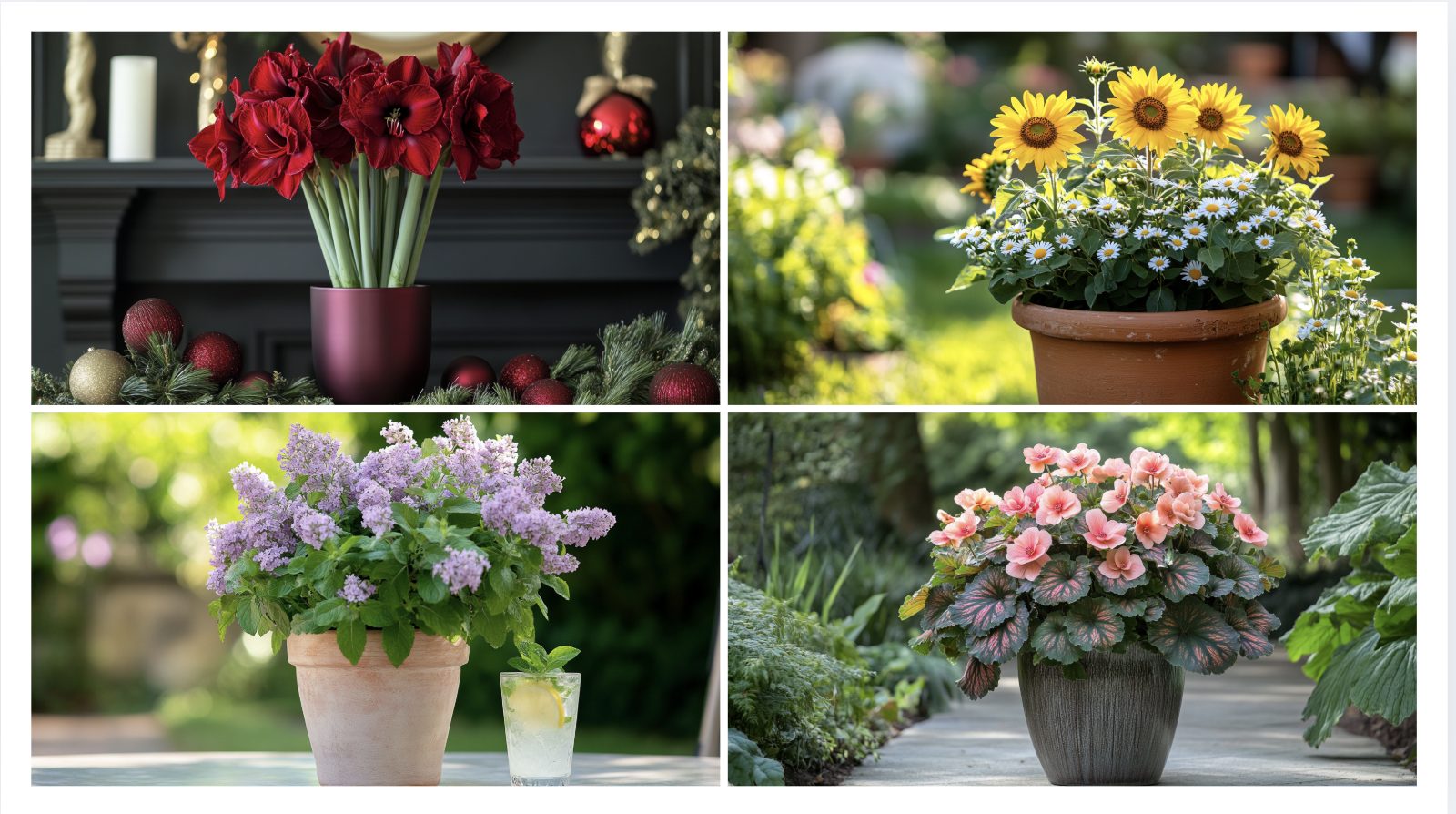Want to add some life to your space but not sure where to start? Container gardening is the perfect way to grow beautiful flowers, whether you have a tiny balcony or a spacious patio.
I’ve assembled creative flower combinations to help you create stunning potted gardens year-round.
From simple succulent arrangements to show-stopping seasonal displays, these combos work for beginners and experienced gardeners.
You can mix and match these ideas to suit your style and space. Ready to get your hands dirty and create something beautiful?
Explore gorgeous flower pot combinations that bring color, texture, and joy to your outdoor space.
The Art of Container Gardening: Flower Edition
1. Succulent And Daisy Combo Pot
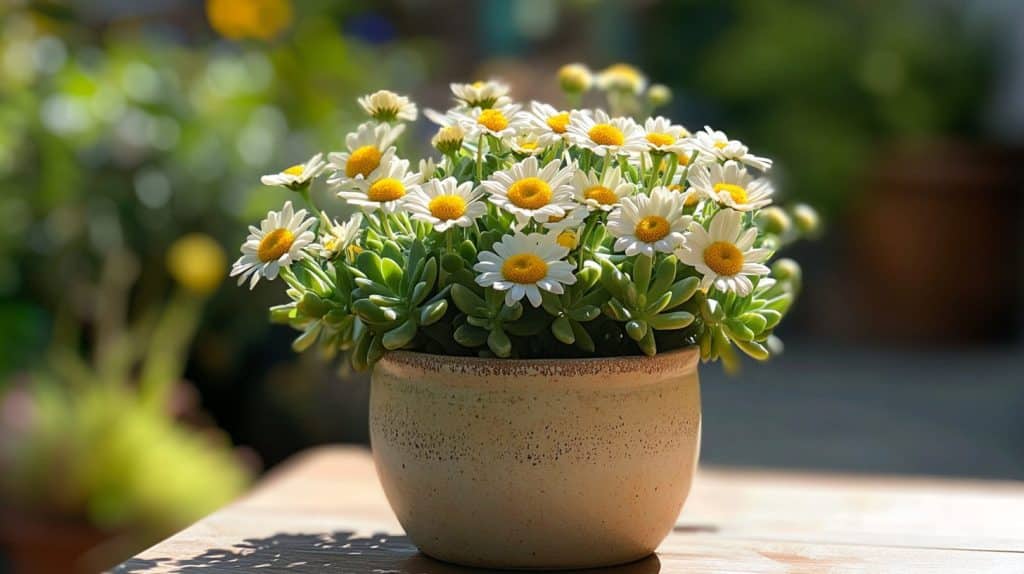
Why settle for just one style when you can mix things up? Pair the structured look of succulents with the soft, colorful blooms of daisies.
This combo creates a pot full of texture and charm. It’s easy to maintain and works indoors or out, especially in sunny spots.
The succulents bring durability, and the daisies add a cheerful touch. Perfect for anyone who loves a little balance in their garden.
DIY Steps:
- Choose a medium-sized pot with drainage holes: Ensure it’s wide enough to accommodate both plants without overcrowding.
- Fill the pot with well-draining soil: Use a mix designed for succulents to prevent waterlogging.
- Plant the succulents first: Arrange them in the back or center for structural height.
- Add daisies around the edges: Their vibrant blooms will create a soft, colorful border.
- Water sparingly: Succulents need less water, so adjust for daisies by monitoring the soil’s top layer.
2. Monochromatic Lavender Pot
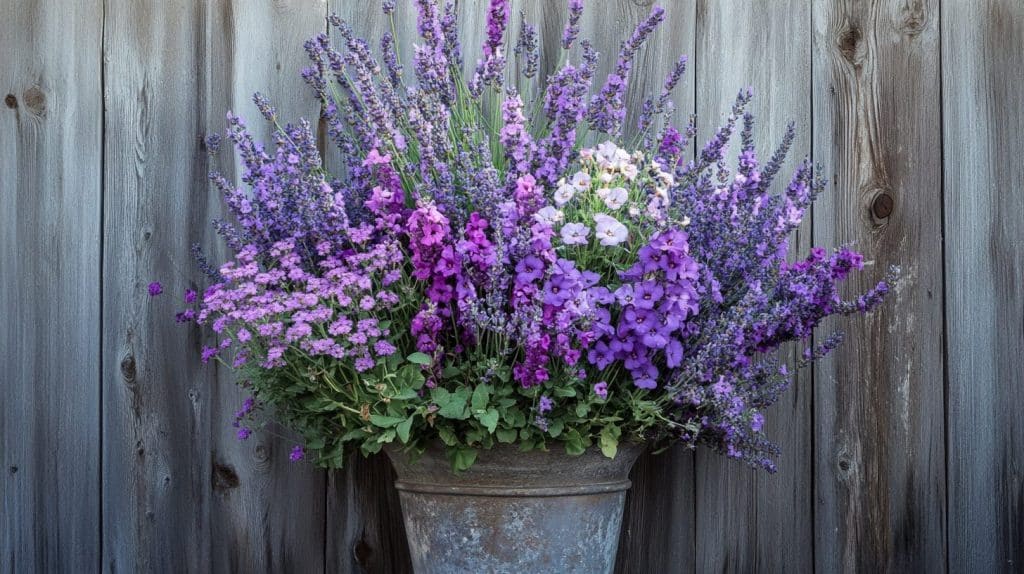
Lavender is soothing in fragrance and visually stunning when planted in varying shades. A pot with soft lilacs and deeper purples creates a calming, monochromatic masterpiece.
It’s a great choice for meditation corners, patios, or even as a welcoming pot by your door. Plus, lavender is easy to care for and keeps your space smelling divine.
It’s magic and simplicity, all wrapped in a single pot.
DIY Steps:
- Select a tall, narrow pot: This complements the upright growth of lavender.
- Use sandy, alkaline soil: Lavender thrives in well-draining, slightly dry conditions.
- Group plants by height: Place the tallest lavender variety in the center or back.
- Leave enough spacing: Lavender bushes need room to spread without crowding.
- Prune regularly: Trim to encourage fuller blooms and keep the plant healthy.
3. Hanging Fern And Orchid Pot
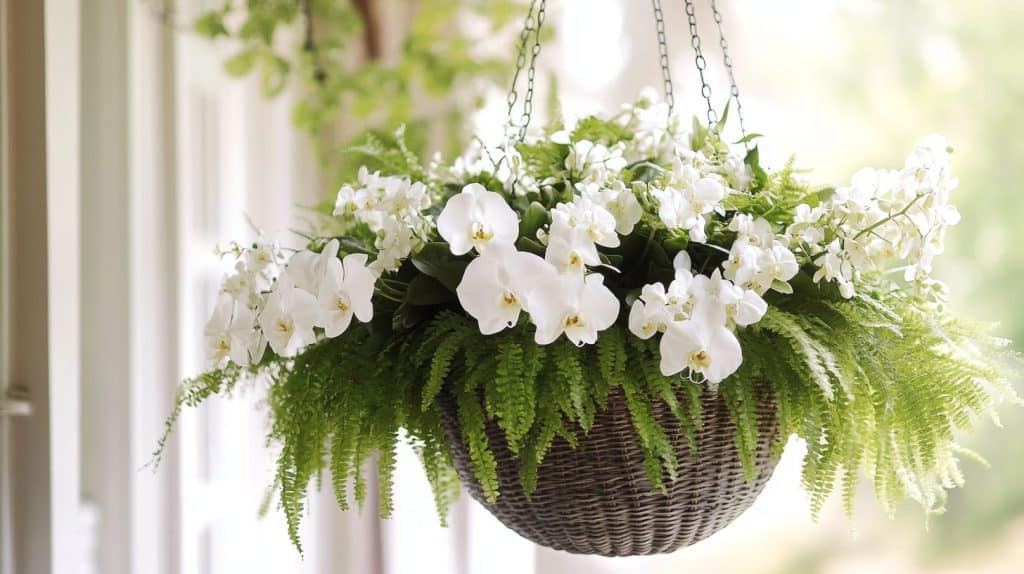
Want to bring tropical vibes to your porch? A hanging fern and orchid pot is just the thing. The lush greenery of ferns pairs beautifully with the soft, exotic flowers of orchids.
This arrangement is all about drama and magic, cascading just the right way. Hang it where there’s shade, and let its beauty transform your space.
Plus, it’s a conversation starter for anyone who visits.
DIY Steps:
- Choose a hanging basket with good drainage: Ensure it can support the weight of the plants.
- Line the basket with moss or coconut coir: This retains moisture while allowing excess water to escape.
- Plant ferns around the edges: Let them cascade over the sides for a lush look.
- Place orchids in the center: Position them upright for a balanced appearance.
- Mist regularly: Orchids and ferns love humidity, so mist them to replicate their natural environment.
4. Bold Sunflower Centerpiece Pot
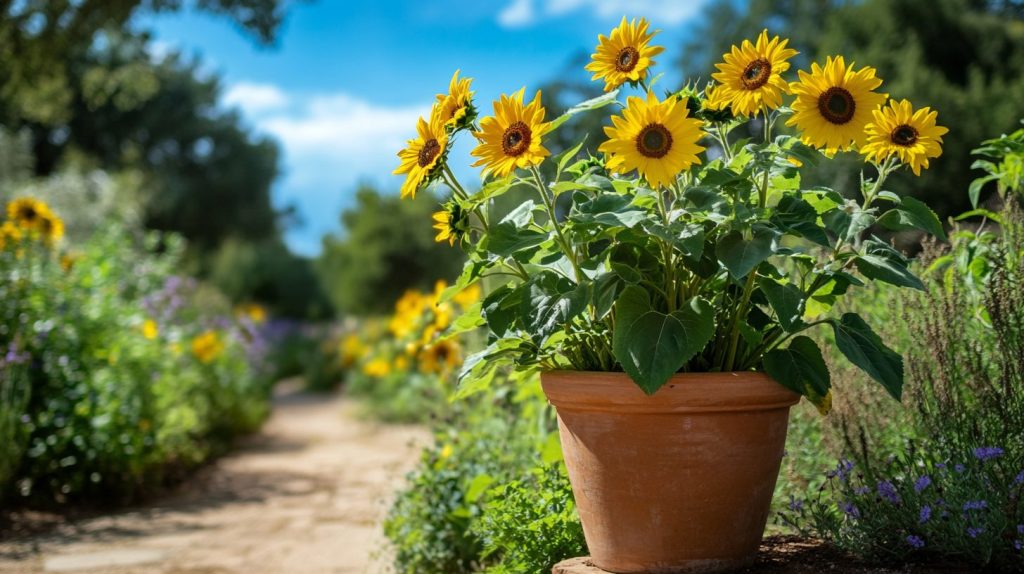
Sunflowers are the answer when you need a centerpiece that screams sunshine and happiness. Their bright yellow blooms and towering presence make them perfect for creating a pot that stands out.
Please place it in a sunny spot, and watch your garden come alive. Sunflowers are hardy, too, so they don’t need much pampering.
They’re bold, cheerful, and oh-so-easy to love.
DIY Steps:
- Choose a deep pot with sturdy support: Sunflowers have strong roots and may require staking.
- Fill with nutrient-rich soil: Add compost for healthy growth.
- Plant sunflower seeds or seedlings: Space them evenly to avoid overcrowding.
- Provide consistent sunlight: Place the pot in a location with 6–8 hours of sunlight daily.
- Water deeply but infrequently: Ensure the soil is moist but not waterlogged.
5. Wildflower Rustic Pot
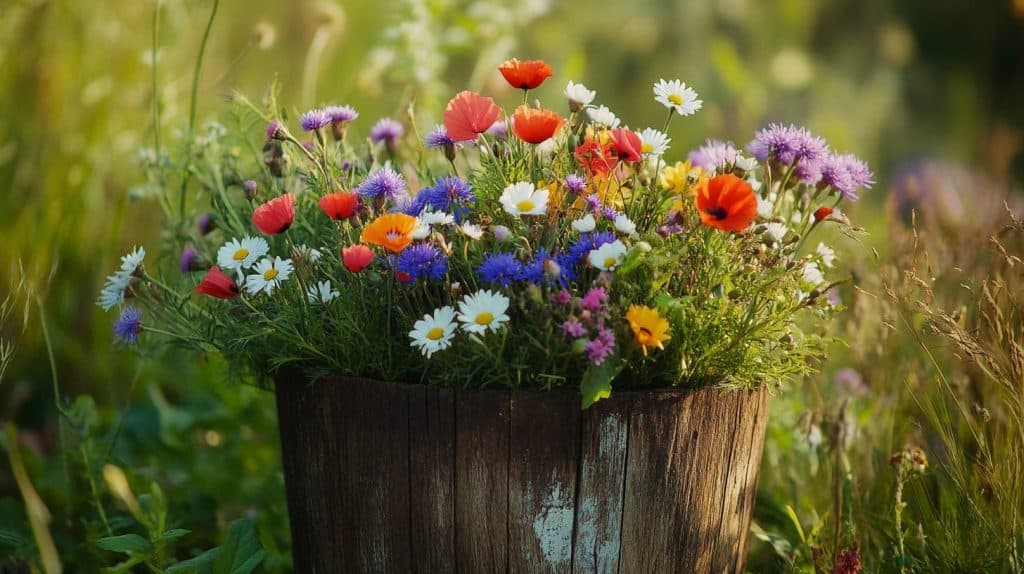
If you love the charm of untamed nature, a wildflower rustic pot is just for you. Filled with a mix of colorful blooms, this arrangement mimics a meadow in miniature.
It’s low-maintenance and has a carefree vibe that’s hard to resist. Pair it with a weathered or wooden pot for added rustic charm.
Place it in your garden or on a patio to bring countryside magic to your home.
DIY Steps:
- Select a weathered or wooden pot: This enhances the rustic vibe.
- Use loamy, well-draining soil: Mix in sand if needed for better drainage.
- Scatter wildflower seeds randomly: Avoid planting them in strict rows for a natural look.
- Water lightly but consistently: Keep the soil damp until germination occurs.
- Trim occasionally: Maintain a balance between wild growth and neatness.
6. White Rose And Ivy Pot
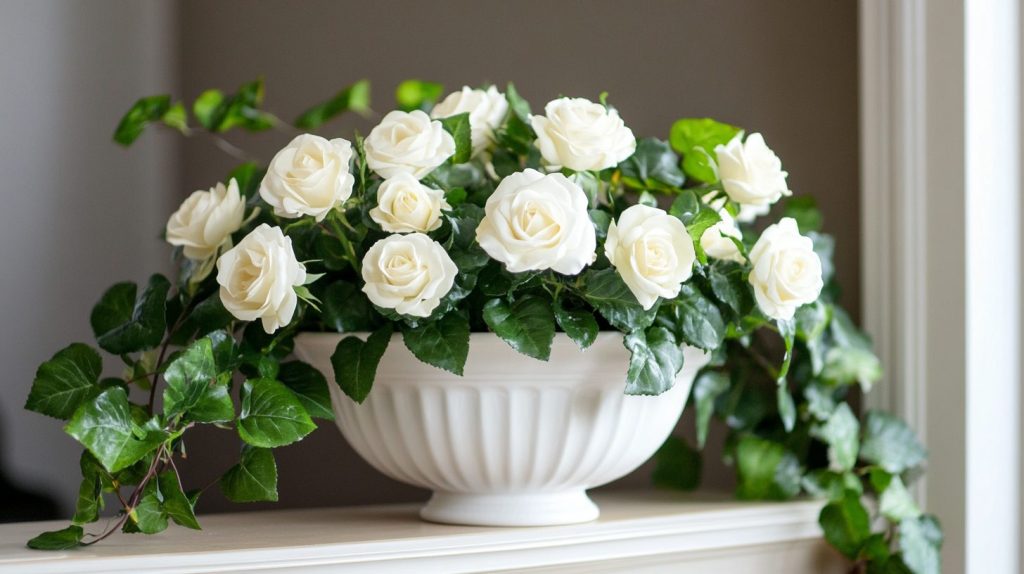
Classic, magical, and timeless – that’s what a white rose and ivy pot brings to your space. The cascading ivy adds a touch of drama, while the roses exude sophistication.
It’s perfect for entryways, dining tables, or even as a gift. And the best part? It’s beautiful and versatile, blending effortlessly with any décor style.
This pot is all about keeping things simple and stunning.
DIY Steps:
- Pick a decorative pot: Choose one that matches the classy theme of white roses.
- Plant roses in the center: Ensure they have enough space for their roots to grow.
- Add ivy around the edges: Let it cascade naturally over the sides.
- Use rich, well-draining soil: Roses thrive in fertile soil, so add organic matter.
- Water consistently: Keep the soil moist, but avoid overwatering to prevent root rot.
7. Tropical Hibiscus And Palm Pot
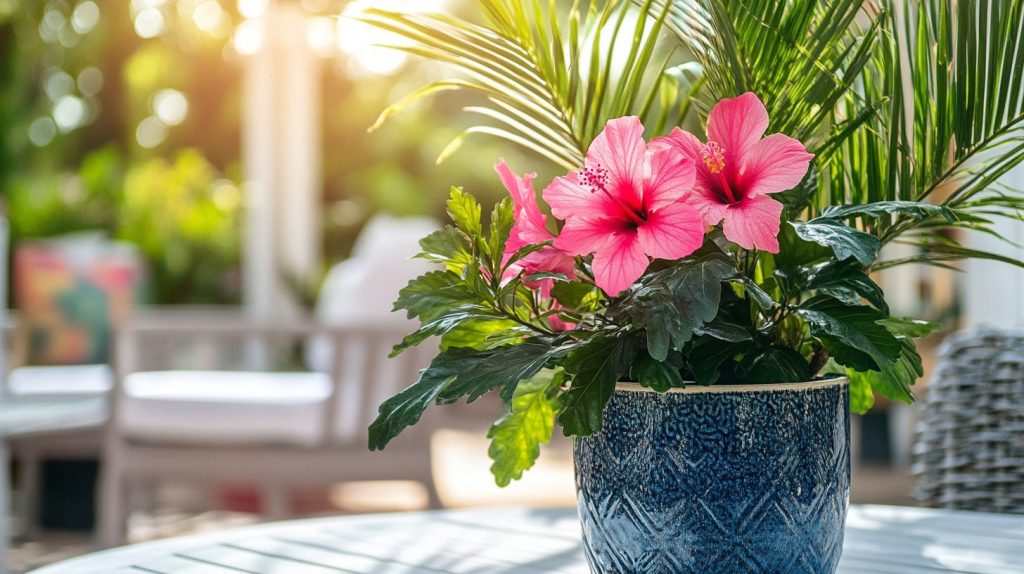
Bring vacation vibes home with a tropical hibiscus and palm pot. The bright, showy hibiscus flowers and mini palms create a lush, exotic feel. It’s like having a slice of paradise right on your patio or balcony.
These plants love the sun and will thrive in warm conditions. They’re not just beautiful to look at; they also create a relaxing, tropical atmosphere you’ll love coming back to.
DIY Steps:
- Select a large, deep pot: Hibiscus and palms need room to grow.
- Use tropical potting mix: Include coconut coir or perlite for good aeration.
- Plant palms in the back: Provide structure and height to the arrangement.
- Add hibiscus in front: Their colorful blooms will shine as the centerpiece.
- Feed with tropical fertilizer: Hibiscus and palms benefit from regular nutrient boosts.
8. Miniature Cactus And Marigold Pot
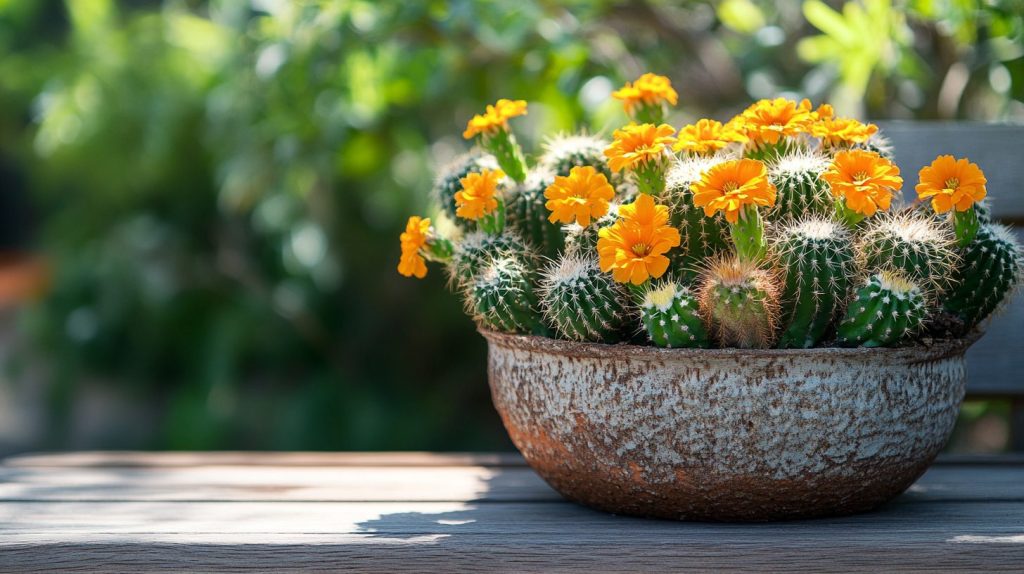
Who says cacti can’t be colorful? Pair miniature cacti with bright marigolds for a pot full of personality. The bold orange and yellow blooms soften the rugged look of the cacti, creating an eye-catching contrast.
This combo is perfect for sunny spots and doesn’t need much water, making it low-maintenance.
It’s a little quirky, vibrant, and fun to have around your garden or home.
DIY Steps:
- Choose a shallow, wide pot: Ensure it has good drainage holes.
- Use cactus soil mix: Add sand or gravel to enhance drainage.
- Plant cacti in the center: Space them apart to avoid competition.
- Add marigolds around the edges: Their bright blooms complement the cacti’s muted tones.
- Water cautiously: Avoid overwatering; focus on the marigolds’ needs without saturating the soil.
9. Petunia Rainbow Pot
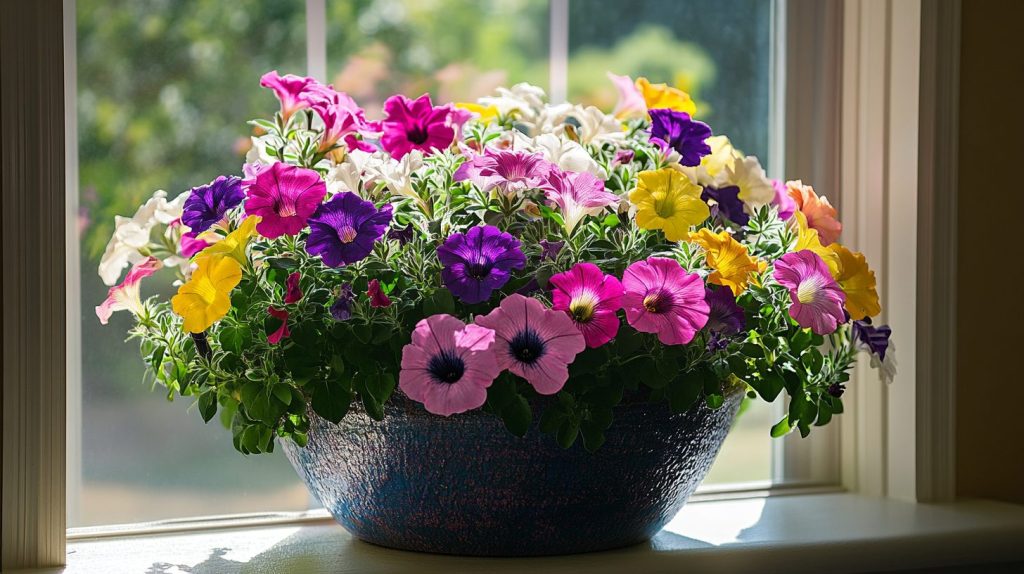
Add a burst of color to your garden with a rainbow pot full of petunias. These flowers come in so many vibrant shades that you’ll have no trouble creating a striking display.
Arrange them in a gradient or mix them up for a playful look. They bloom profusely and thrive in sunny locations, making them perfect for patios or window boxes.
This post is all about spreading cheer wherever it’s placed.
DIY Steps:
- Pick a wide, medium-depth pot: Ensure the pot allows room for spreading petunias.
- Use nutrient-rich, well-draining soil: Petunias thrive in fertile soil with good drainage.
- Plant petunias in clusters by color: Arrange them to create a gradient or rainbow effect.
- Position in full sunlight: Petunias need at least 6 hours of sunlight daily.
- Water regularly: Keep the soil moist but not soggy to maintain healthy blooms.
10. Succulent And Baby’s Breath Pot
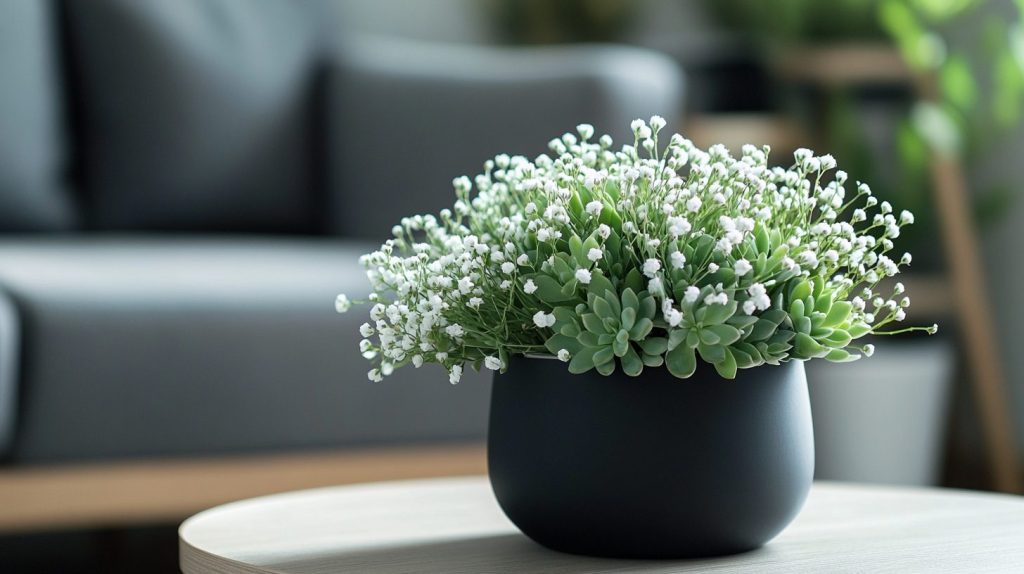
Soft meets sturdy in this unique pairing of succulents and baby’s breath. The soft white flowers of baby’s breath beautifully contrast the bold textures of succulents.
This arrangement works indoors or outdoors, adding a sophisticated yet casual vibe. It’s easy to maintain and looks fresh year-round.
Whether on a coffee table or by your window, this pot will catch everyone’s attention without trying too hard.
DIY Steps:
- Choose a shallow, decorative pot: Succulents require a well-draining container.
- Use cactus or succulent soil: Add sand or perlite for better drainage.
- Plant succulents first: Arrange them at varying heights for visual interest.
- Add baby’s breath as filler: Tuck it around the succulents for a soft touch.
- Water sparingly: Baby’s breath and succulents need minimal water to thrive.
11. Tulip And Grass Arrangement Pot
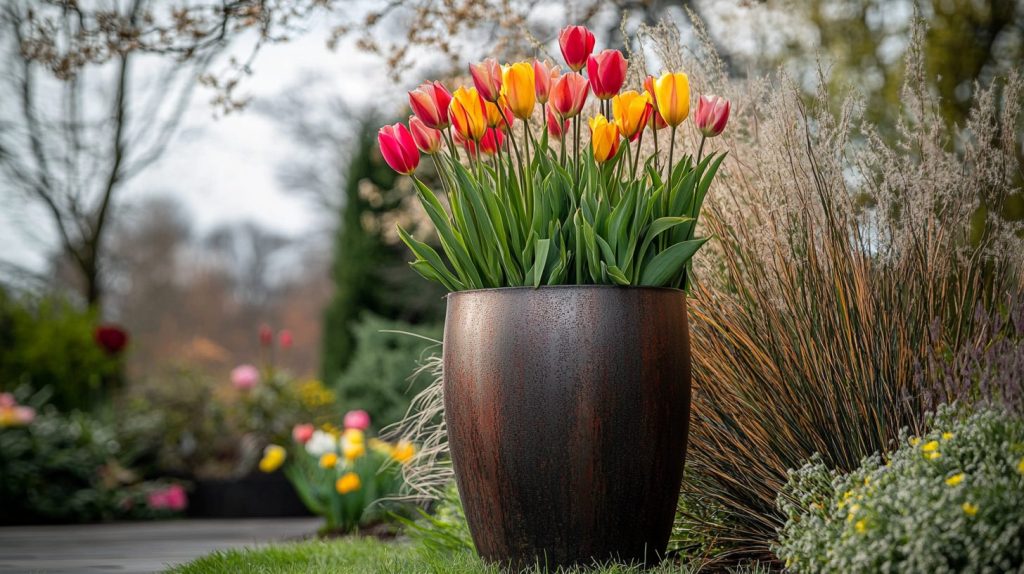
A tulip and grass pot is a great way to add height and magic to your spring garden. The tall, vibrant tulips pair wonderfully with ornamental grass, creating a versatile, layered look.
It’s simple yet sophisticated, perfect for garden paths or front porches. The gentle sway of the grass adds movement, while the tulips bring vibrant pops of color.
Together, they create a harmonious display that’s hard to ignore.
DIY Steps:
- Select a deep pot with proper drainage: Tulips and grass have strong root systems.
- Fill with loose, sandy soil: Ensure good drainage for tulips to thrive.
- Plant tulip bulbs first: Space them evenly across the pot.
- Add ornamental grass around the edges: This complements the tulips without overshadowing them.
- Place in partial to full sunlight: Water moderately to keep the soil moist.
12. Hydrangea Mix Pot
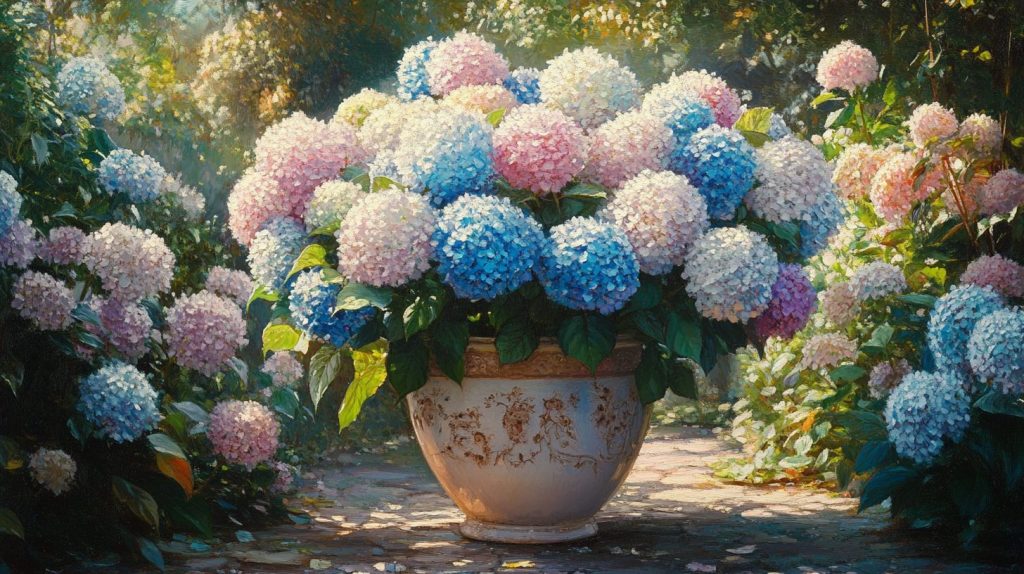
Hydrangeas in a pot? Absolutely! These lush, cloud-like blooms are perfect for creating a dreamy arrangement. Mix different shades—soft blues, pinks, or whites—for a calming and harmonious look.
This pot thrives in shaded areas, making it ideal for patios or cool garden corners. With their full, rounded flowers, hydrangeas add a sense of abundance and magic wherever you place them.
Plus, they’re surprisingly easy to care for.
DIY Steps:
- Choose a large, sturdy pot: Hydrangeas require ample space for their roots.
- Use acidic soil for color variation: The soil’s pH can enhance their hues.
- Plant taller hydrangeas in the center: Arrange smaller varieties around the edges.
- Water frequently: Keep the soil consistently moist, but avoid waterlogging.
- Place in partial shade: Protect them from direct, harsh sunlight.
13. Herb And Nasturtium Pot
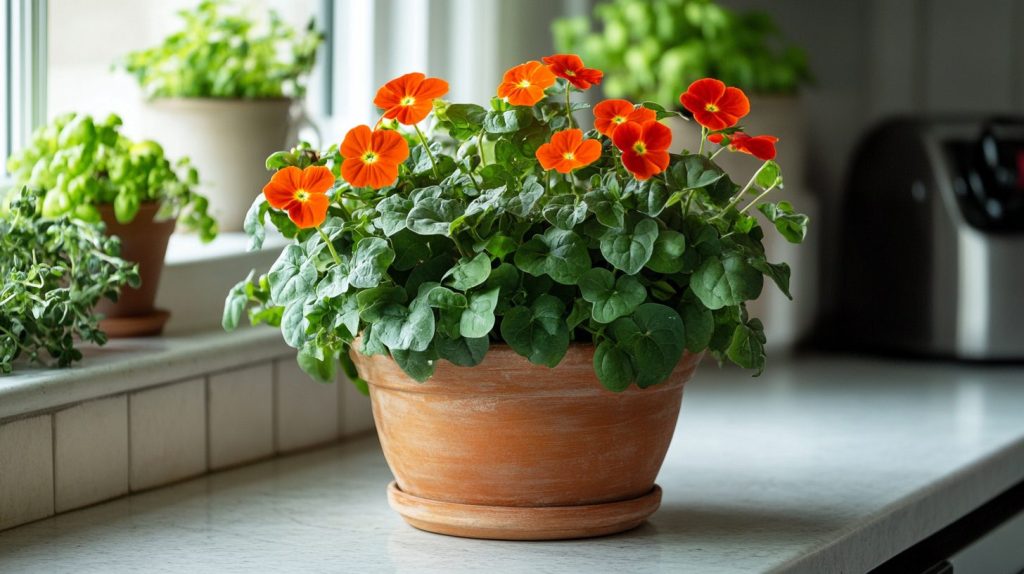
Why not combine beauty and practicality? An herb and nasturtium pot does just that. The bright, edible nasturtium flowers pair perfectly with fragrant herbs like basil or thyme.
It’s a functional and decorative addition to your kitchen or balcony. You get fresh herbs for cooking and vibrant blooms for visual appeal.
This pot is a win-win, bringing both color and utility to your gardening game.
DIY Steps:
- Select a wide, shallow pot: Ensure there’s enough space for both plant types to thrive.
- Use nutrient-rich potting soil: Add compost to boost growth.
- Plant herbs in the center: Choose varieties like basil, thyme, or parsley.
- Add nasturtiums along the edges: Their bright blooms and trailing nature enhance the style.
- Water consistently: Keep the soil moist but not overly saturated.
14. Mini Rose Garden Pot
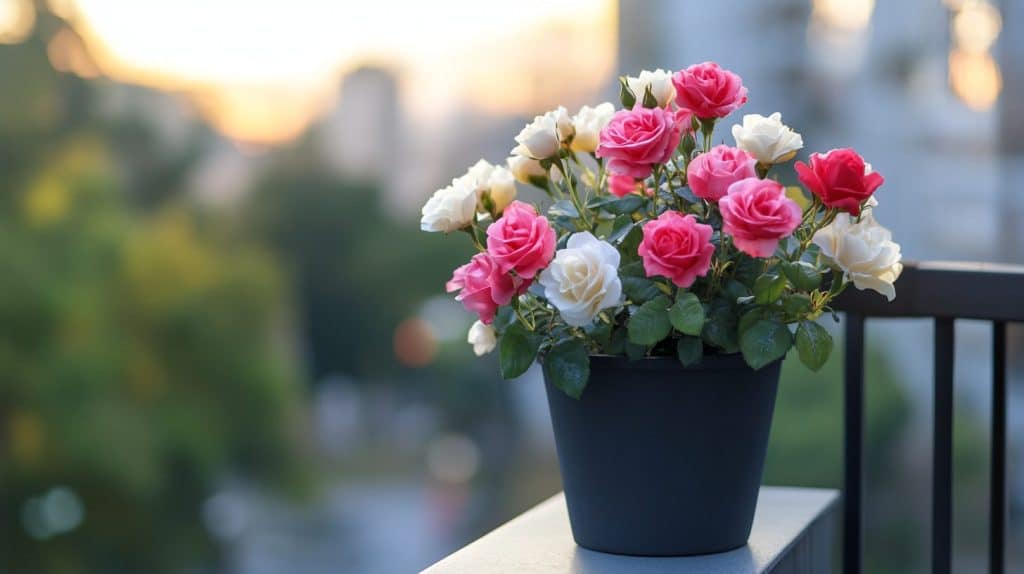
If you love roses but don’t have space for a full garden, a mini rose garden pot is the perfect solution. These compact roses come in a variety of colors and look just as stunning as their larger counterparts.
They’re great for patios, balconies, or even indoors near a sunny window. Their soft beauty adds a touch of romance and charm to any space.
Plus, they’re surprisingly easy to grow with a little love and care.
DIY Steps:
- Select a deep pot with proper drainage: Roses need space for their roots to grow.
- Use nutrient-rich soil: Mix in organic compost for optimal growth.
- Plant miniature rose bushes: Space them evenly to allow for air circulation.
- Place in a sunny location: Roses require at least 6 hours of sunlight daily.
- Water deeply but less frequently: Let the soil dry slightly between waterings.
15. Dahlia Burst Pot
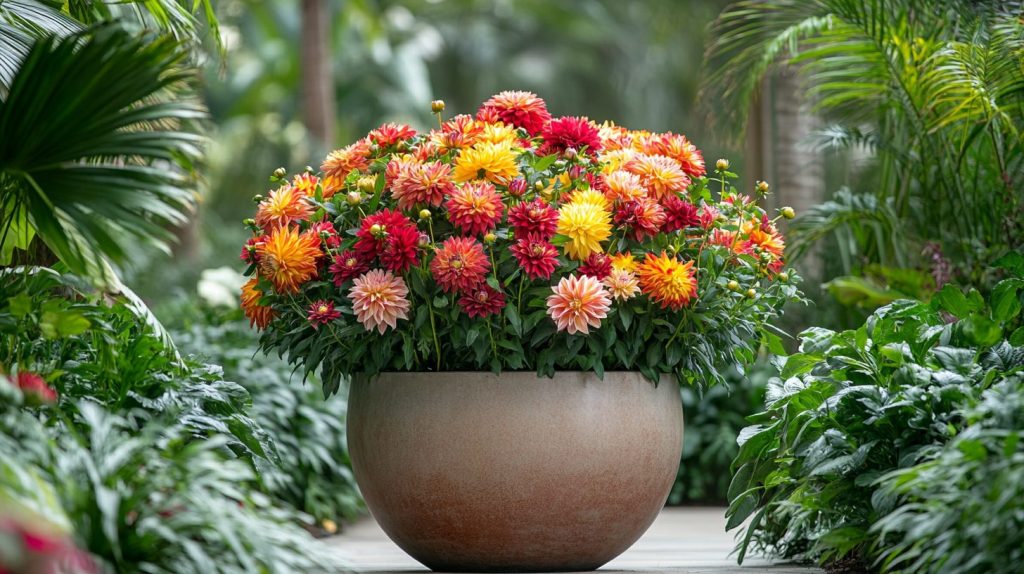
If you want a pot that grabs attention, dahlias are the way to go. Their bold, showy blooms come in a variety of colors, making them perfect for a vibrant display.
Plant them in a deep pot, and let their large flowers steal the show.Dahlias bloom all summer, adding life and energy to your garden or patio.
They’re an easy way to bring a pop of color to any corner of your home.
DIY Steps:
- Choose a large, deep pot: Dahlias have tuberous roots that require space.
- Use well-draining, sandy soil: Ensure the soil remains loose for tuber growth.
- Plant dahlia tubers horizontally: Cover with 2–3 inches of soil.
- Provide full sunlight: Dahlias need 6–8 hours of sun daily for optimal blooms.
- Water consistently: Keep the soil moist but not waterlogged.
16. Orchid And Moss Pot
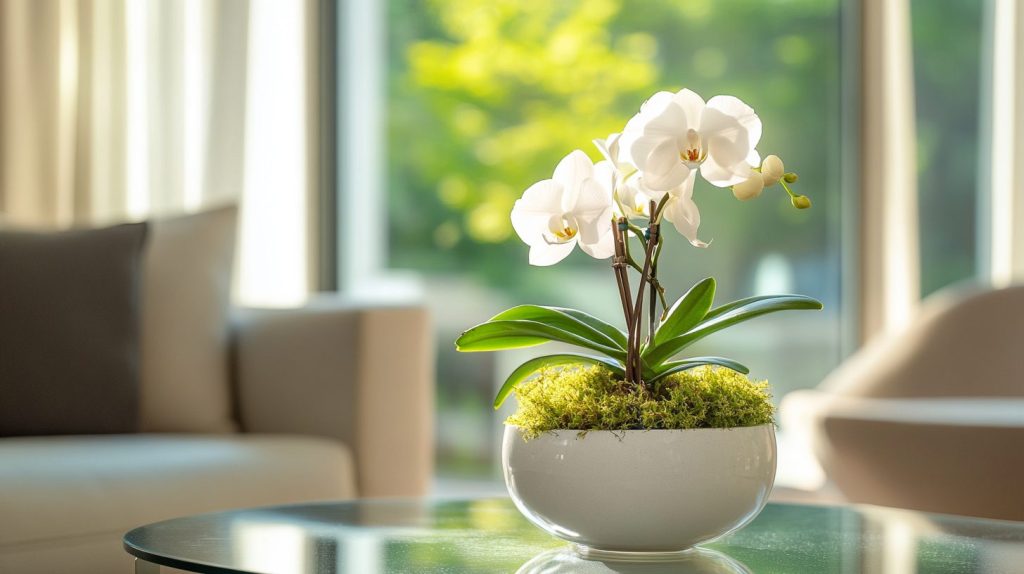
Add a touch of magic to your space with orchids paired with soft green moss. This combo creates a pot that’s minimalist yet striking.
Orchids bring exotic beauty, while moss adds a natural, grounding effect.Perfect for indoor spaces, this arrangement thrives with a bit of care and humidity.
Whether it’s for a coffee table or a corner shelf, this pot makes a statement without overwhelming the room.
DIY Steps:
- Select a decorative ceramic or glass pot: Orchids prefer a stable container with proper drainage.
- Use orchid potting mix: Include bark or sphagnum moss for proper airflow.
- Plant the orchid upright: Support its stem with a stake if necessary.
- Cover the surface with green moss: This enhances moisture retention and adds visual appeal.
- Mist the plant regularly: Orchids thrive in humid environments.
17. Begonia Layered Pot
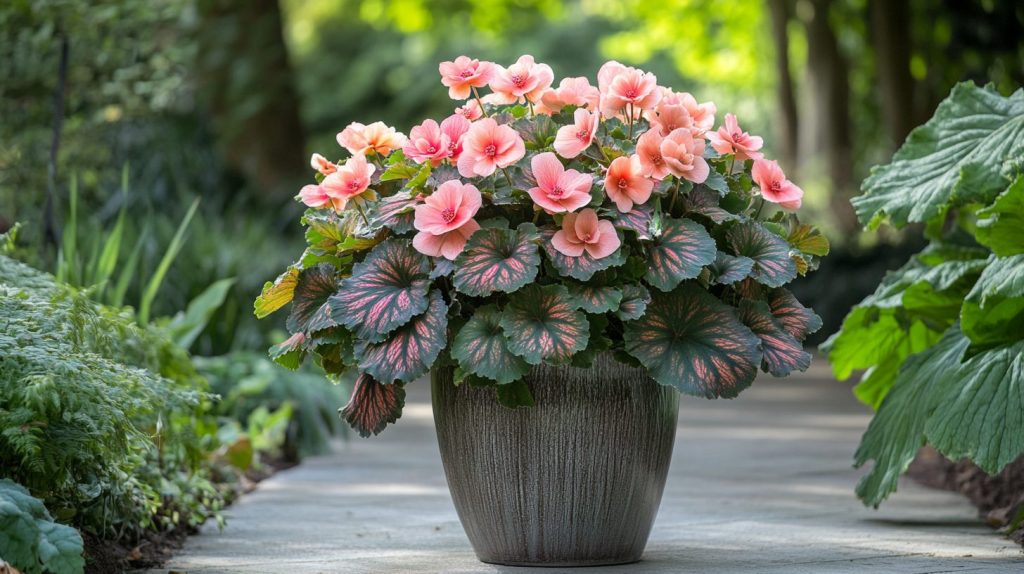
Layering begonias in a pot is a brilliant way to add depth and variety to your garden. Use begonias in different colors and sizes to create a visually varied display.
They thrive in shaded areas, making them ideal for porches or under trees. With their lush foliage and continuous blooms, begonias offer an effortless way to keep your space looking fresh and lively.
They’re low-maintenance and simply gorgeous.
DIY Steps:
- Pick a medium-sized pot with drainage holes: Begonias require good airflow to prevent root rot.
- Use a mix of soil and peat moss: This ensures well-drained but moisture-retentive soil.
- Plant taller begonias in the center: Gradually add smaller ones toward the edges.
- Place in partial shade: Avoid harsh sunlight to prevent leaf burn.
- Water moderately: Let the soil dry slightly between waterings.
18. Zinnia And Cosmos Duo Pot
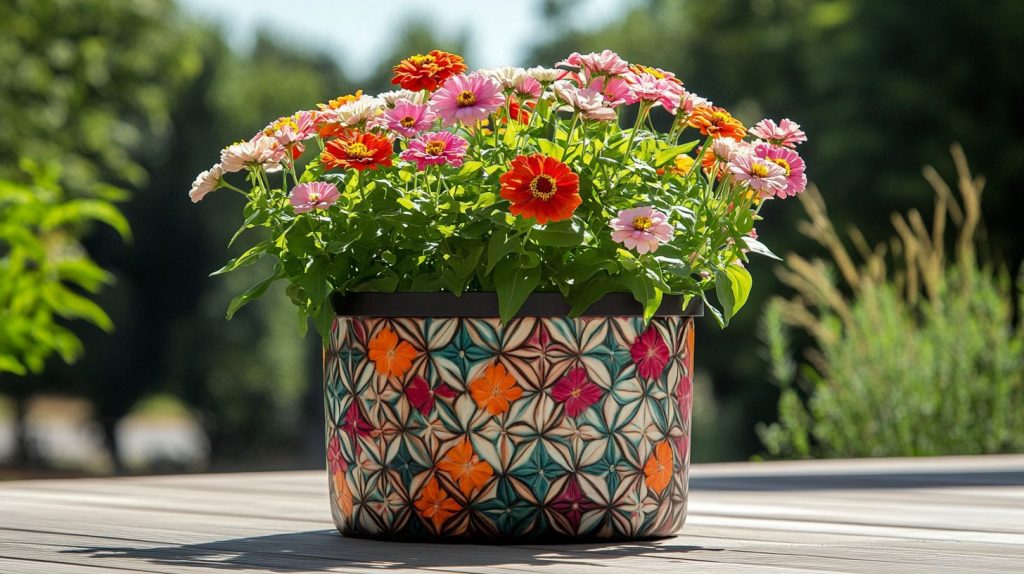
Zinnias and cosmos are a match made in heaven for a cheerful pot full of color and texture. Both flowers bloom abundantly, adding vibrancy and charm to sunny spots.
Zinnias bring bold, structured flowers, while cosmos add a soft, airy touch. Together, they create a pot that’s full of life and personality.
This arrangement is perfect for brightening up patios, decks, or any space that needs a little extra joy.
DIY Steps:
- Select a wide, shallow pot: Ensure enough space for both flowers to spread.
- Use nutrient-rich, well-draining soil: Add compost for healthier blooms.
- Plant zinnias and cosmos alternately: Their vibrant colors and textures complement each other.
- Provide full sunlight: These flowers thrive in bright, sunny locations.
- Water consistently: Keep the soil moist but not soggy.
19. Pansy Delight Pot
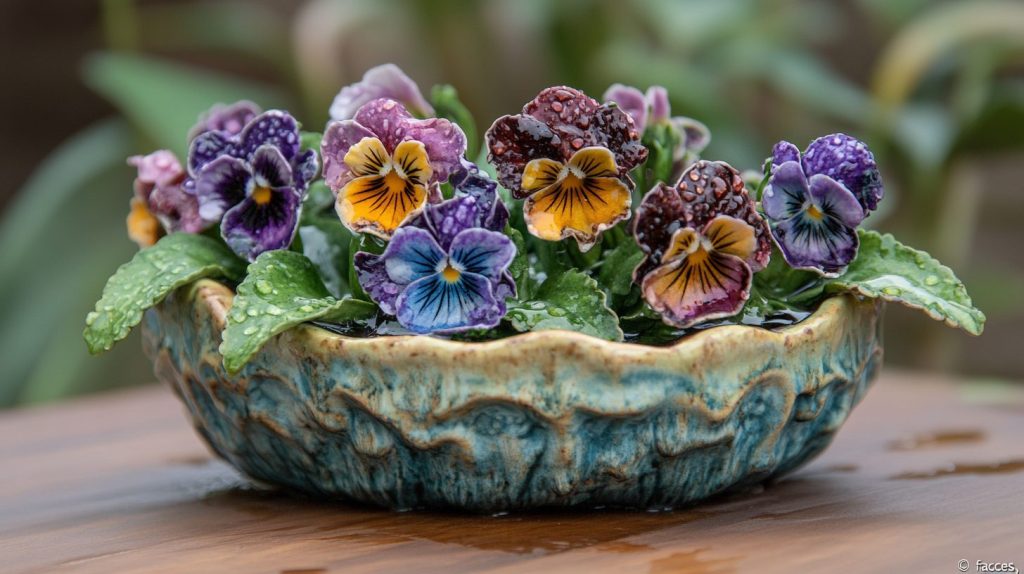
Pansies are small but mighty when it comes to bringing color and happiness to your garden. With their wide range of colors and unique “faces,” they’re perfect for creating a playful pot.
Pansies thrive in cool weather, making them a great choice for spring and fall displays.
Their compact size means you can plant plenty in one pot, creating a dense, cheerful arrangement that’s sure to make you smile every time you see it.
DIY Steps:
- Pick a shallow, wide pot: Pansies have shallow roots, so a deep pot is not necessary.
- Use a lightweight potting mix: Ensure the soil is rich and drains well.
- Plant pansies in clusters: Arrange them by complementary colors for a cohesive look.
- Place in partial sunlight: Pansies thrive in cool weather and dappled sunlight.
- Water consistently: Keep the soil moist, especially during dry periods.
20. Fuchsia Cascade Pot
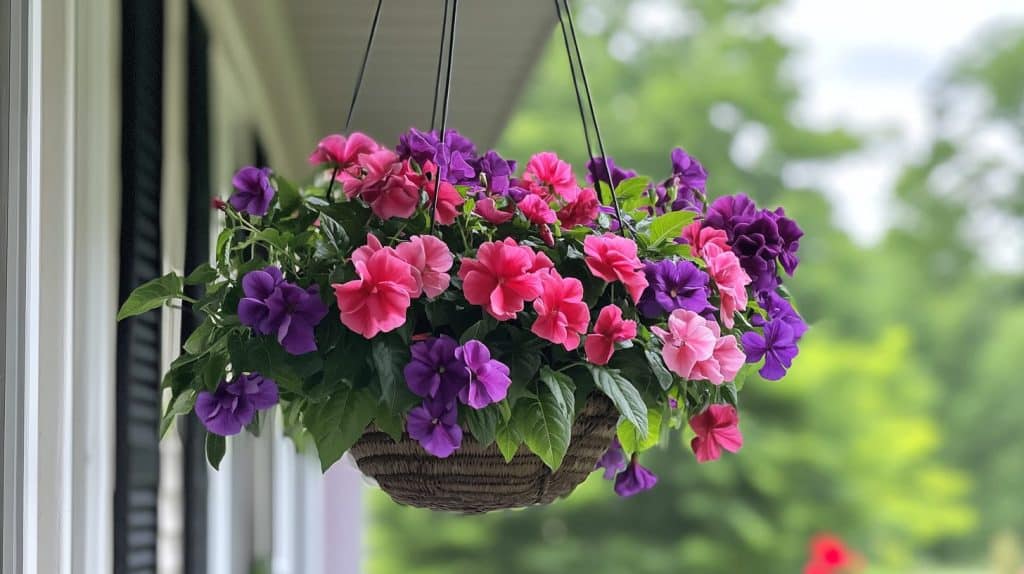
Fuchsias are the perfect choice if you want a pot with cascading beauty. Their drooping flowers create a waterfall effect that’s stunning in hanging baskets or raised pots.
With vibrant colors ranging from pink to purple, they bring tropical vibes to any space. Fuchsias thrive in partial shade, making them ideal for porches or balconies.
They’re a little exotic, a little playful, and completely gorgeous.
DIY Steps:
- Choose a hanging basket or tall pot: Ensure it allows the flowers to cascade freely.
- Use soil enhanceed with compost: Fuchsia thrives in moist, nutrient-rich soil.
- Plant fuchsia near the edges: Let the flowers drape naturally over the pot.
- Place in partial shade: Fuchsias prefer cool, shaded areas.
- Water regularly: Keep the soil moist but avoid waterlogging.
21. Daffodil And Tulip Spring Pot
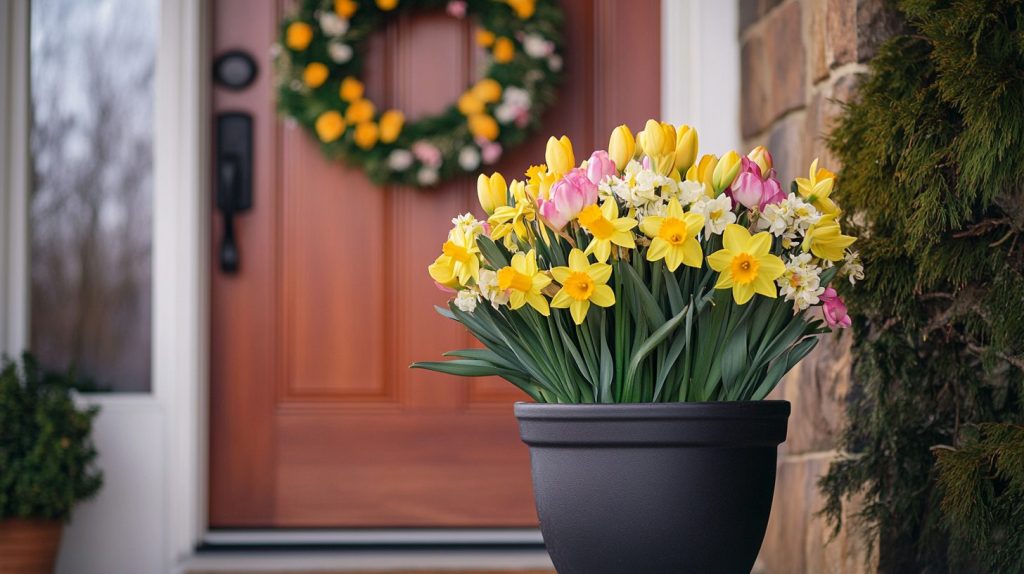
Nothing says spring like a pot bursting with daffodils and tulips. The bright yellows and soft pastels of these flowers create a fresh, seasonal look that’s hard to beat.
They’re easy to grow and bring instant cheer to your garden or patio. This arrangement works well near entrances or along pathways, making it a warm and welcoming sight.
With these two blooms together, your pot will be the highlight of the season.
DIY Steps:
- Select a deep pot with drainage holes: Both flowers need room for their bulbs.
- Layer the bulbs in the soil: Place tulip bulbs deeper than daffodil bulbs for staggered growth.
- Use sandy, well-draining soil: This prevents the bulbs from rotting.
- Place in full sunlight: Daffodils and tulips require ample sunlight to bloom.
- Water sparingly: Keep the soil moist until the bulbs sprout.
22. Chrysanthemum Fall Pot
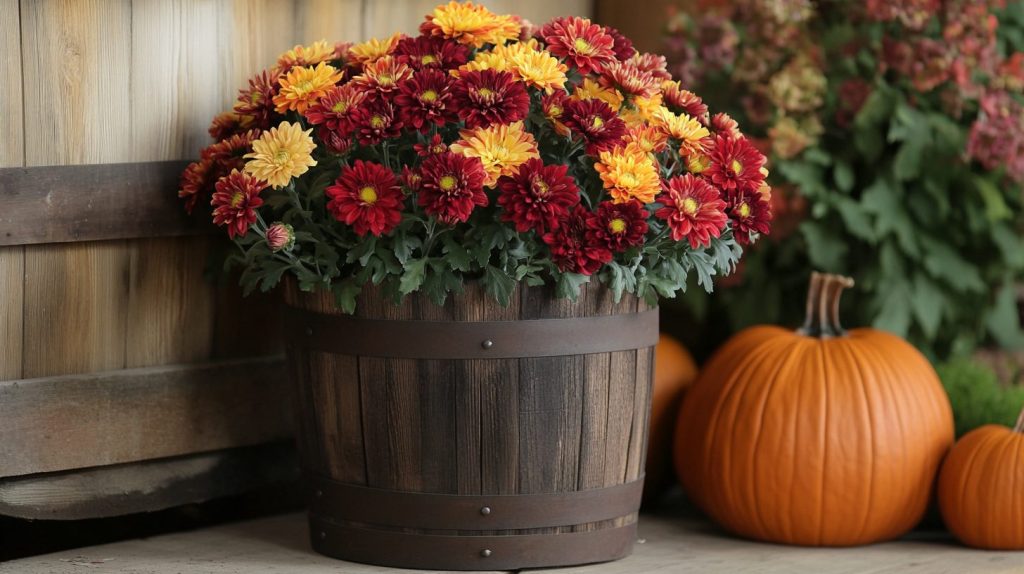
Chrysanthemums, or mums, are the perfect flowers to celebrate the colors of fall. Their dense, rounded blooms come in warm hues like orange, red, and yellow, making them a seasonal favorite.
A chrysanthemum pot is great for adding autumnal charm to patios or garden corners. They’re hardy, easy to care for, and bloom for weeks, keeping your space vibrant even as the weather cools.
Perfect for cozying up your outdoor areas.
DIY Steps:
- Choose a medium-depth pot: Ensure it’s wide enough to fit multiple chrysanthemum plants.
- Use nutrient-rich soil: Add organic matter to promote healthy growth.
- Plant mums in clusters: Group colors like yellow, orange, and red for a fall-themed arrangement.
- Place in bright, indirect sunlight: They prefer moderate light conditions.
- Water consistently: Keep the soil evenly moist to encourage longer blooming.
23. Geranium And Daisy Pairing Pot
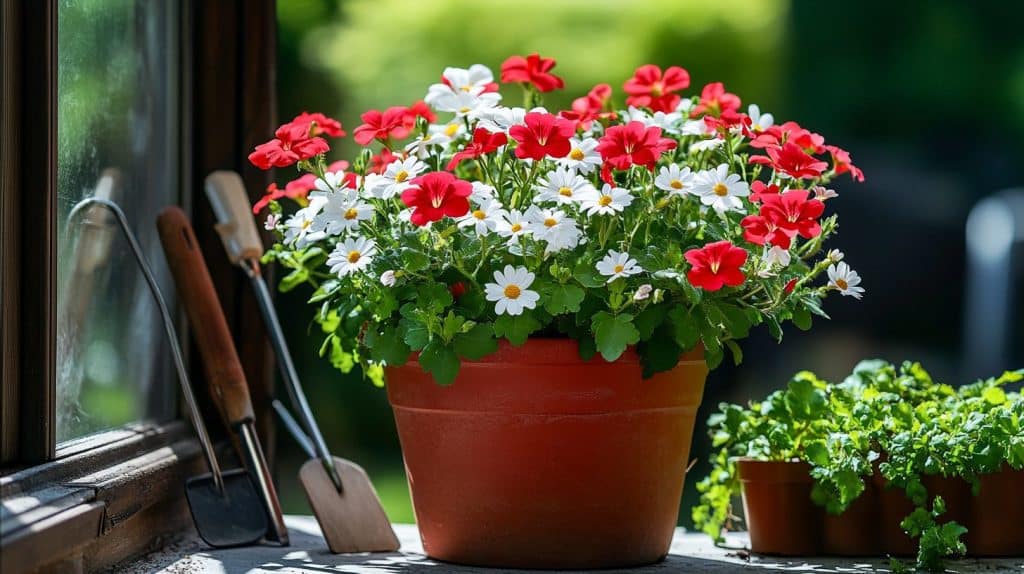
Classic geraniums meet cheerful daisies in this delightful pot arrangement. The bold, structured blooms of geraniums contrast beautifully with the soft petals of daisies.
Together, they create a balanced and timeless look that works in almost any setting. This pot thrives in sunny spots and adds a welcoming vibe to porches, patios, or garden paths.
It’s a simple, low-maintenance choice that’s full of charm and personality.
DIY Steps:
- Select a medium-sized, sturdy pot: Geraniums have strong roots that need support.
- Fill with well-draining soil: Use a mix designed for flowering plants.
- Plant geraniums in the center: Their bold blooms create the pot’s focal point.
- Add daisies around the edges: Their soft flowers soften the arrangement.
- Provide full sunlight: Water regularly to keep the plants healthy and blooming.
24. Crocus Miniature Garden Pot
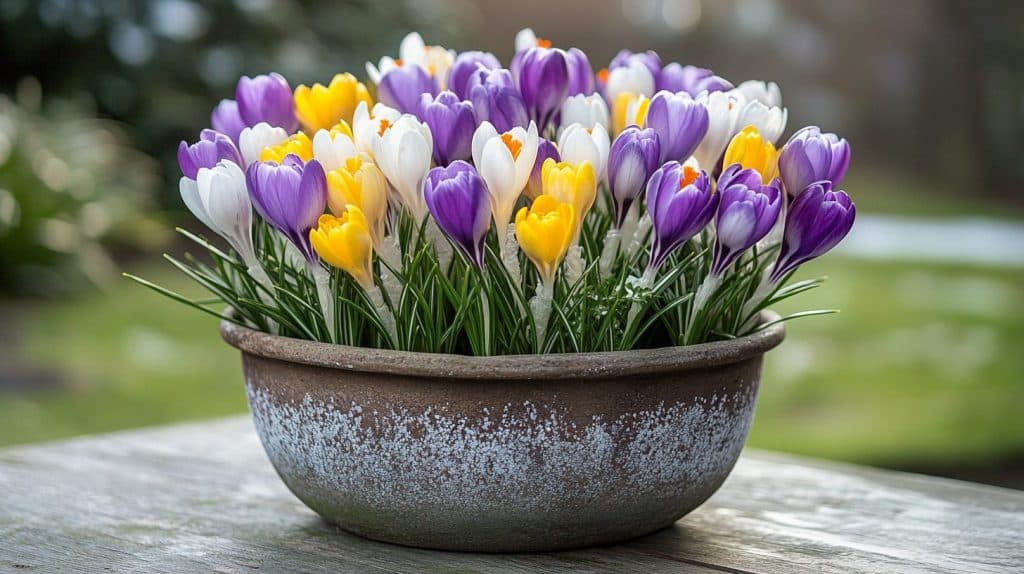
Crocuses may be small, but they pack a big punch when it comes to adding color. Their bright, cup-shaped blooms create a lively miniature garden, perfect for small spaces.
These early spring flowers are ideal for shallow pots and work well as a centerpiece for outdoor tables.
They’re low-maintenance and bloom just when you need a touch of color the most, making them a great choice for adding a little joy to your garden.
DIY Steps:
- Choose a shallow, wide pot: Crocuses have small bulbs and require limited depth.
- Use loose, sandy soil: This prevents water retention and supports bulb growth.
- Plant crocus bulbs closely: Space them about 2 inches apart for a dense display.
- Place in full sunlight: Crocuses bloom best with ample light exposure.
- Water sparingly: Keep the soil lightly moist until sprouts appear.
25. Amaryllis Showstopper Pot
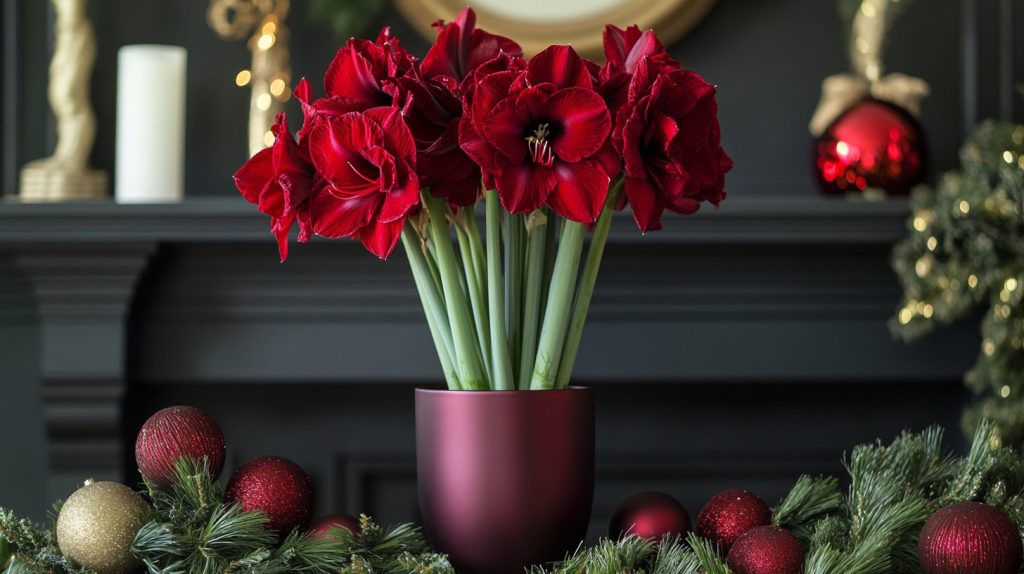
Amaryllis is the star of any arrangement with its tall stalks and bold, trumpet-shaped flowers. A pot with amaryllis is all about making a statement.
These striking blooms are perfect for indoor spaces, adding a touch of magic to living rooms or entryways. They thrive with minimal care, and their long-lasting flowers make them a favorite for holiday or special occasion décor.
It’s the kind of pot that demands attention in the best way.
DIY Steps:
- Select a tall, narrow pot: Amaryllis bulbs need depth but not much width.
- Use well-draining soil: Add a layer of gravel at the bottom for added drainage.
- Plant the bulb halfway into the soil: Leave the top portion of the bulb exposed.
- Place in bright, indirect sunlight: Rotate the pot occasionally for even growth.
- Water sparingly: Allow the soil to dry out between waterings to prevent rot.
26. Lily Of The Valley Pot
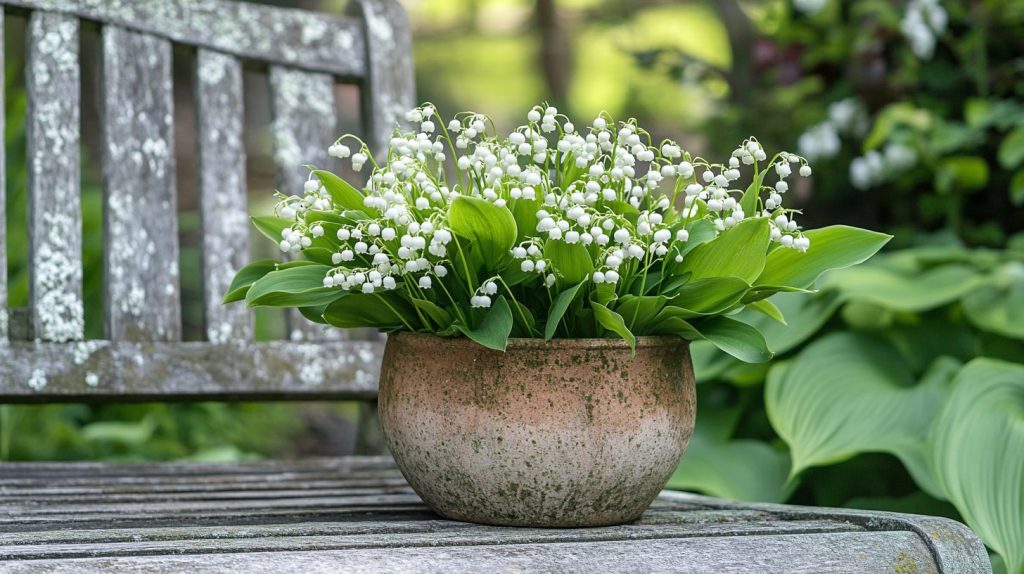
Soft and fragrant, lily of the valley is a timeless choice for a potted arrangement. Its tiny, bell-shaped blooms add a touch of charm and serenity to shaded spaces.
Perfect for patios, balconies, or indoor corners, this pot brings an understated magic wherever it’s placed. It’s also easy to grow, thriving in cool, damp conditions.
If you’re looking for something simple yet stunning, this pot is the way to go.
DIY Steps:
- Choose a small to medium-sized pot: Ensure it has good drainage holes.
- Use rich, loamy soil: Add organic matter to promote healthy root growth.
- Plant rhizomes shallowly: Cover them lightly with soil.
- Place in partial to full shade: These flowers thrive in cooler, shaded areas.
- Water regularly: Keep the soil moist, as they prefer damp conditions.
27. Mixed Succulent Flower Pot
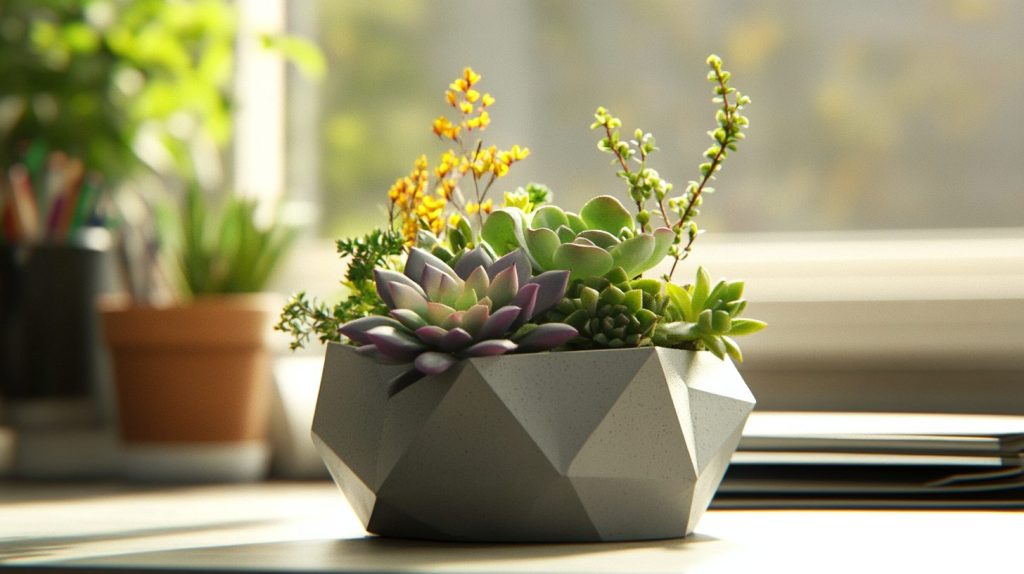
Combine flowering succulents with their textured green counterparts to create contrast and interest.
Succulents are low-maintenance, making this arrangement perfect for busy gardeners. Add varieties that bloom in vibrant colors for an extra pop of life. This pot thrives in sunny spots and works well indoors or out.
The arrangement keeps looking good all year round with very little effort.
DIY Steps:
- Choose a shallow, wide pot: Succulents require ample surface-spreading space.
- Use cactus potting mix: Ensure the soil drains well to prevent overwatering.
- Plant taller succulents in the center: Surround them with trailing or rosette varieties.
- Add flowering succulents as accents: Place them strategically for pops of color.
- Water sparingly: Allow the soil to dry out completely between waterings.
28. Snapdragon Vertical Pot
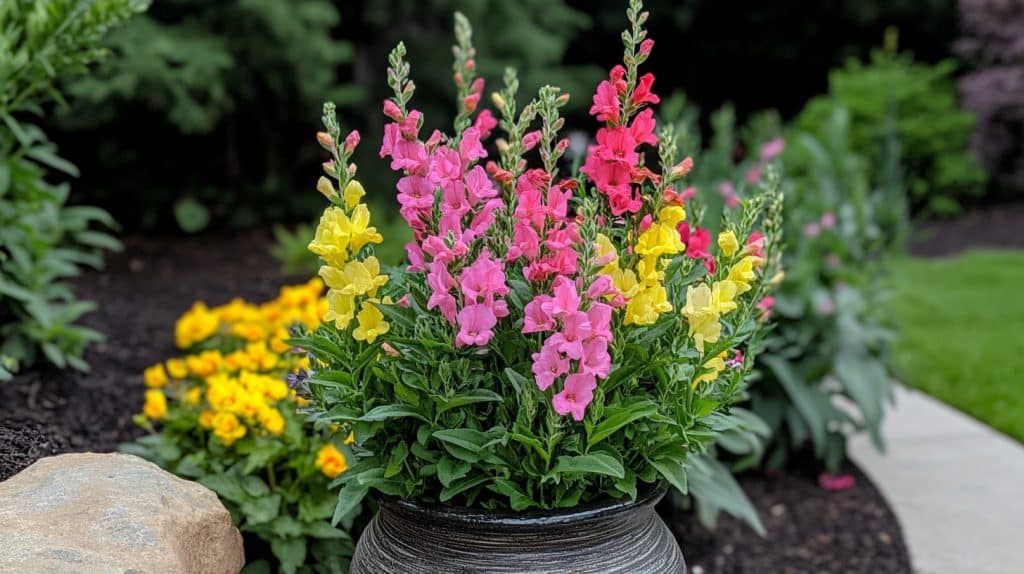
Snapdragons are a fantastic way to add height and structure to your garden. Their tall, colorful stalks look stunning in a vertical pot arrangement.
Plant snapdragons in the center or back of the pot for a layered effect, and let their blooms steal the show.
These flowers thrive in sunny spots and bloom profusely, making them a bright and cheerful addition to any space. A snapdragon pot is bold, vibrant, and full of personality.
DIY Steps:
- Select a deep, narrow pot: Snapdragons need support for their tall growth.
- Use nutrient-rich, well-draining soil: Add compost for vibrant blooms.
- Plant snapdragons in the center: Space them evenly for a balanced display.
- Support with stakes if needed: Tie the stalks gently to prevent bending.
- Place in full sunlight: Water regularly to keep the soil moist but not soggy.
29. Daisy And Sunflower Combo Pot
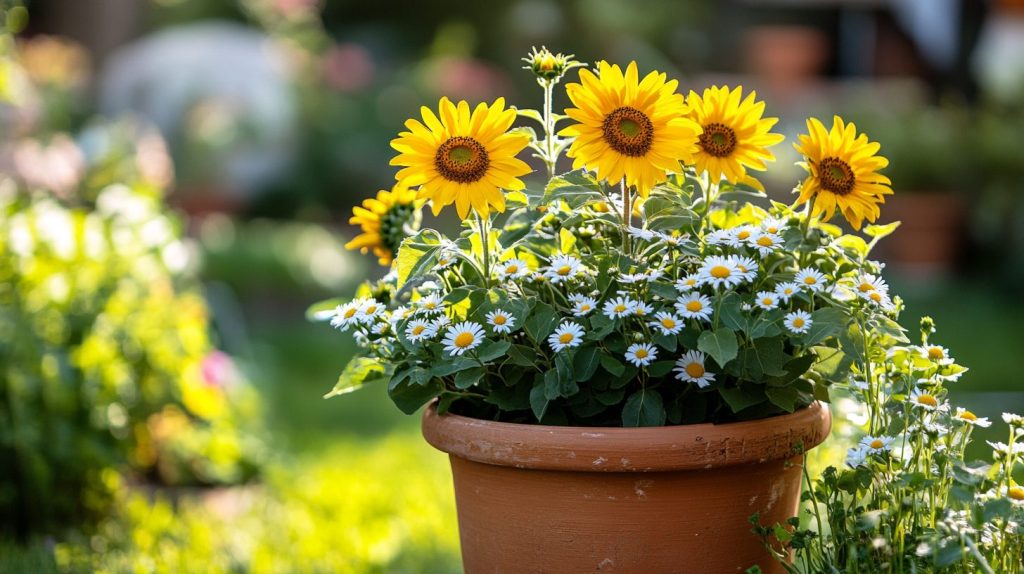
Pairing the small, charming daisies with the bold, towering sunflowers creates a delightful mix of scale and color. This pot is perfect for a sunny spot in your garden or on your patio.
The cheerful daisies soften the dramatic presence of sunflowers, creating a balanced yet playful arrangement.
It’s a great way to bring a touch of the countryside into your home, adding warmth and positivity to any outdoor space.
DIY Steps:
- Choose a deep, wide pot: Sunflowers need depth, and daisies require spreading space.
- Use a nutrient-rich soil mix: Add compost for better flower production.
- Plant sunflowers toward the back or center: They serve as the pot’s focal point.
- Add daisies around the edges: Their small blooms soften the arrangement.
- Water regularly: Keep the soil evenly moist for both flowers to thrive.
30. Clematis Climbing Pot
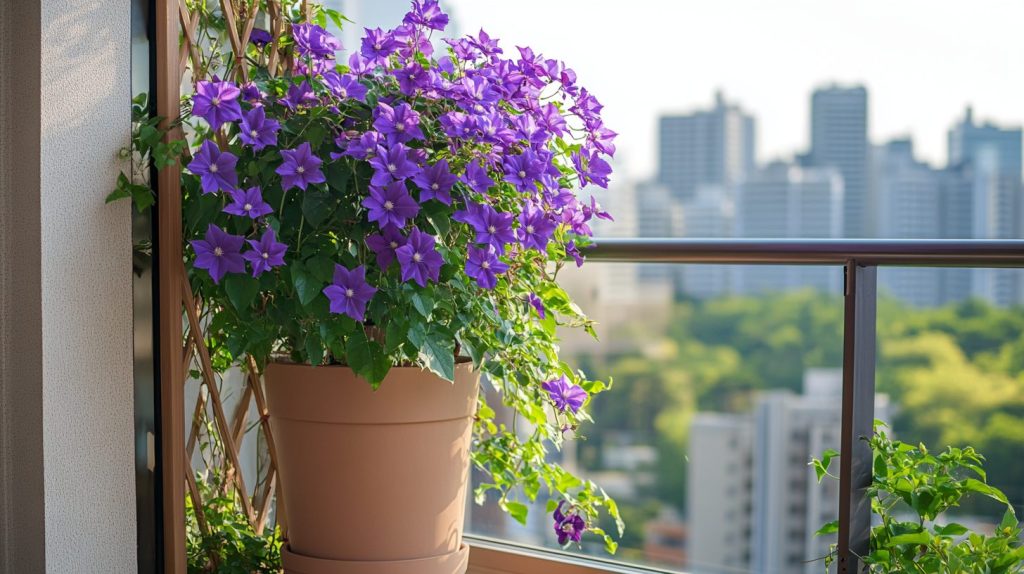
Clematis is all about vertical beauty. This climbing plant adds magic and drama to any garden. Clematis can transform small spaces into something extraordinary in a pot with a trellis or support.
Its vibrant, star-shaped flowers bloom in stunning shades of purple, pink, or white.
Perfect for patios or balconies, this pot creates a varied display that grows and evolves throughout the season. It’s a living piece of art for your home.
DIY Steps:
- Select a tall pot with a built-in trellis: Clematis needs support for climbing.
- Use rich, well-draining soil: Add organic matter to enhance growth.
- Plant the clematis near the trellis base: Guide its vines toward the structure as it grows.
- Place in partial to full sunlight: Ensure the roots remain shaded with mulch or stones.
- Water deeply and regularly: Keep the soil consistently moist but not soggy.
31. Peony And Ranunculus Luxury Pot
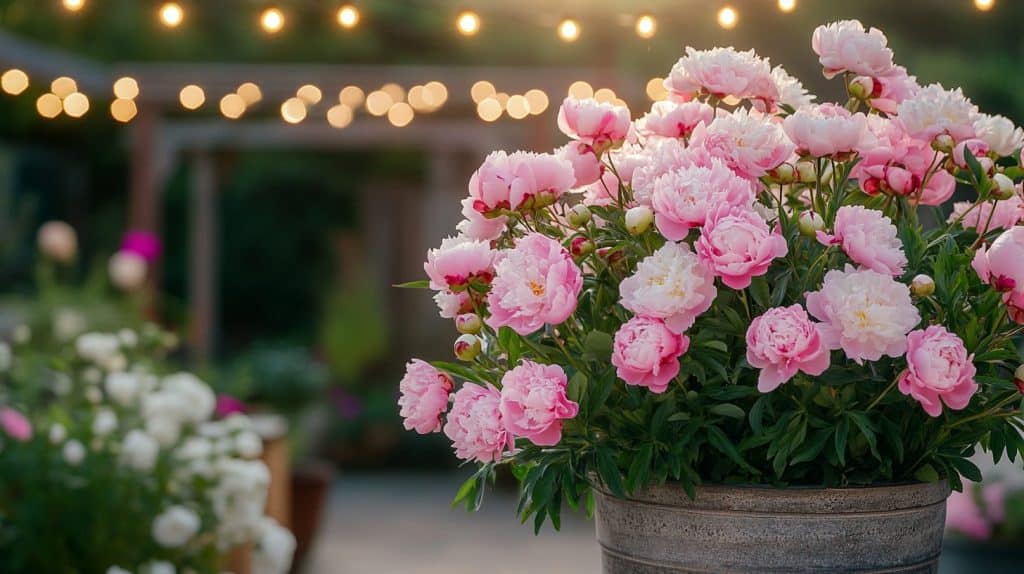
Peonies and ranunculus create a lush, luxurious, and utterly romantic pot. Peonies bring big, full blooms, while ranunculus adds a soft, layered touch.
This combination works wonderfully for special occasions or to raise your garden. Please place it in a sunny or partly shaded spot and enjoy the soft, pastel colors these flowers offer.
It’s a classic choice that always feels high-end without much effort.
DIY Steps:
- Select a large, decorative pot that complements the elegant flowers.
- Use rich, loamy soil: Mix in compost for nutrient-rich conditions.
- Plant peonies at the center: Space them for ample root growth.
- Add ranunculus around the edges: Their soft flowers provide a contrasting texture.
- Water moderately: Ensure the soil is moist but well-draining to avoid waterlogging.
32. Bougainvillea Topiary Pot
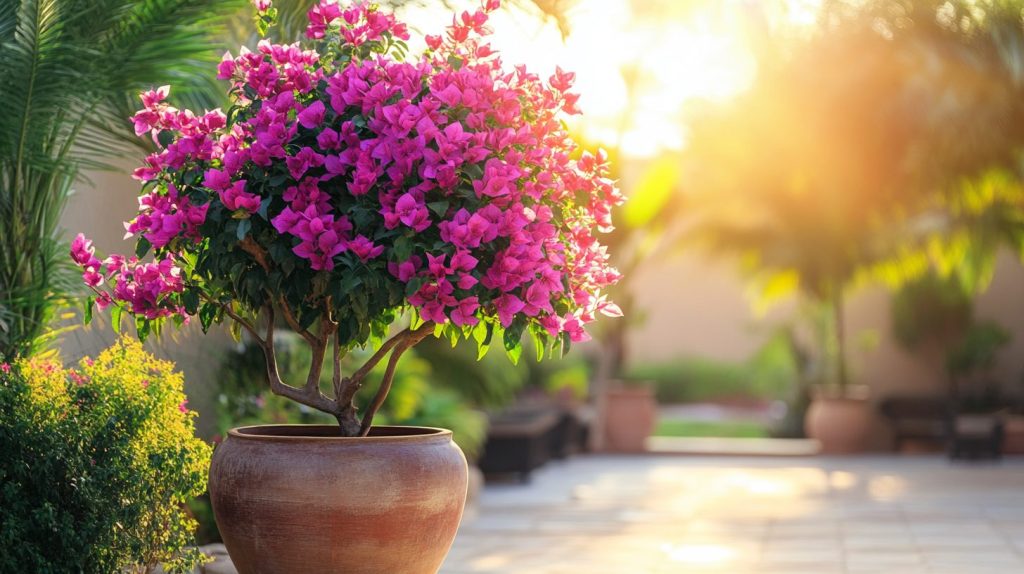
Turn your bougainvillea into a stunning topiary for a bold, exotic look. The vibrant, paper-like flowers create an eye-catching display in a well-pruned, structured arrangement.
This pot thrives in sunny spots and is perfect for creating a tropical vibe on patios or poolside areas.
With a little training and care, bougainvillea can become a show-stopping feature that feels like a piece of paradise right at home.
DIY Steps:
- Choose a deep, sturdy pot: Bougainvillea has a strong root system.
- Use sandy, well-draining soil: This mimics its natural environment.
- Train the bougainvillea onto a topiary frame: Use ties to secure its growth along the structure.
- Place in full sunlight: This plant thrives in warm, bright conditions.
- Water sparingly: Allow the soil to dry between waterings to prevent root rot.
33. Lilac And Mint Pot
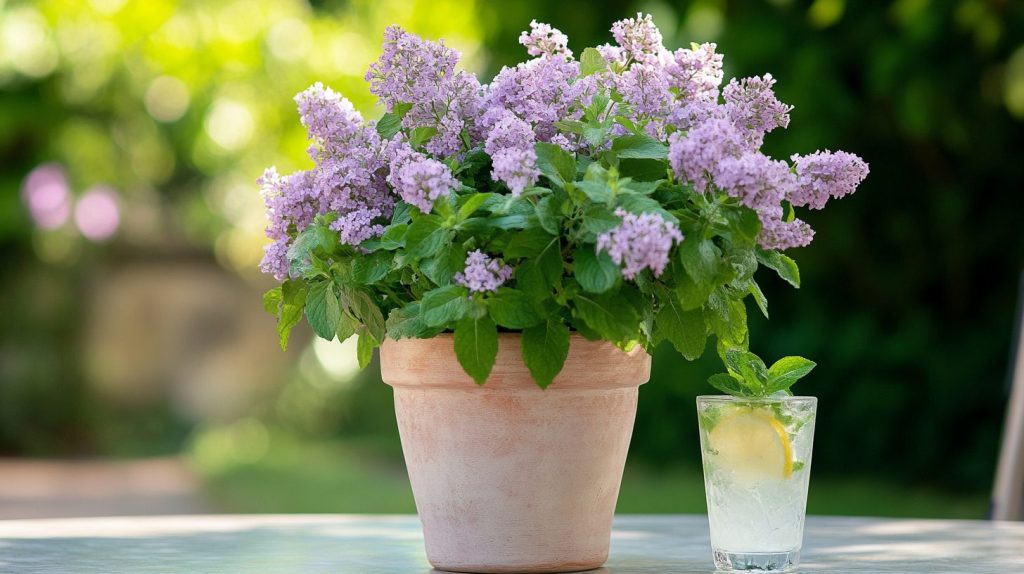
Pair fragrant lilacs with refreshing mint for a pot that smells as good as it looks. The pastel purple blooms of lilacs contrast beautifully with the lush green mint leaves.
This arrangement works well in partial sunlight and adds a soothing, aromatic touch to patios or kitchen gardens.
It’s as practical as beautiful, giving you a fresh mint for your drinks or recipes while brightening up your space with lilac charm.
DIY Steps:
- Select a medium-sized pot: Ensure it has good drainage holes.
- Use rich, moist soil: Mint prefers consistently moist conditions, while lilacs tolerate slightly drier soil.
- Plant lilacs in the center: Provide structure and fragrance as the focal point.
- Add mint around the edges: Their bright green leaves create a lush contrast.
- Place in partial sunlight: Water frequently to maintain soil moisture.
Conclusion
These flower pot ideas are just the starting point for your container garden. Not every combination will match your style or space, and that’s fine.
Start small – maybe with one or two pots – and see what works best in your area. Watch how different spots get sun or shade, test out various plants, and most importantly, have fun with it.
Some plants will thrive, others might need more care, but that’s how we learn and grow as gardeners.
There’s no such thing as a perfect garden – each pot tells its own story.
So pick up some containers, grab your favorite flowers, and create your own outdoor space, one pot at a time.

